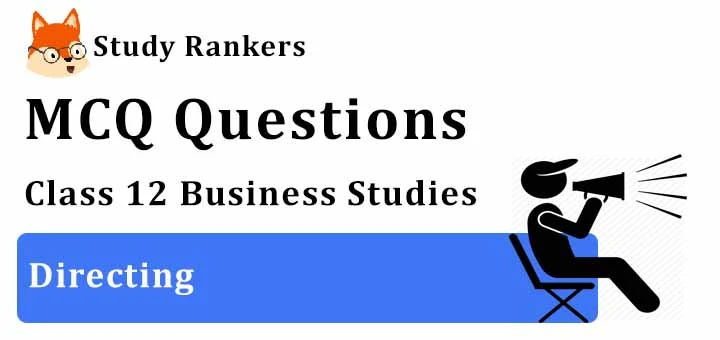MCQ Questions for Class 12 Business Studies: Ch 7 Directing

1. Bonus, Promotion and Recognition are the example of _____________
(a) Controlling
(b) Positive Motivation
(c) Staffing
(d) Planning
► (b) Positive Motivation
2. The process of converting the message into communication symbols is known as-
(a) Decoding
(b) Encoding
(c) Feedback
(d) Media
► (b) Encoding
3. Esteem needs are concerned with ____________
(a) Affection
(b) Prestige and Self-respect
(c) Friendship
(d) Acceptance
► (b) Prestige and Self-respect
4. The motivation theory which classifies needs in hierarchical order is developed by
(a) Fred Luthans
(b) Abraham Maslow
(c) Scott
(d) Peter F. Drucker
► (b) Abraham Maslow
5. Punishment and stopping increments etc. are the examples of __________
(a) Communication
(b) Positive Motivation
(c) Supervision
(d) Negative Motivation
► (d) Negative Motivation
6. Directing is concerned with the following elements _______________
(a) Communication
(b) Supervision and Motivation
(c) Leadership
(d) All of the above
► (d) All of the above
7. Two way communication technique is used under _________________
(a) Laissez Faire
(b) Democratic style
(c) Autocratic style
(d) None of the above
► (b) Democratic style
8. Hierarchy Theory of Motivation was given by ________
(a) Abraham Maslow
(b) Peter Maslow
(c) Henry Maslow
(d) David Maslow
► (a) Abraham Maslow
9. Which of the following is not a leadership style?
(a) Free-rein
(b) Autocratic
(c) Democratic
(d) Dictatorship
► (d) Dictatorship
10. Which of the following is a financial incentive?
(a) Job Security
(b) Promotion
(c) Employee Participation
(d) Stock Incentive
► (d) Stock Incentive
11. Basic Physiological Needs are concerned with ____________
(a) Shelter
(b) Hunger
(c) Thirst
(d) All of the above
► (d) All of the above
12. Supervision means _________________
(a) Planning for the future
(b) Starting a business
(c) Fulfilment of legal formalities
(d) Overseeing what is being done by subordinates
► (d) Overseeing what is being done by subordinates
13. One way communication system is used under ____________
(a) Authoritative Style of Leadership
(b) Free-rein
(c) Democratic
(d) None of the above
► (a) Authoritative Style of Leadership
14. Workers chit-chating in a canteen about the behaviour of supervisor is ______ type of communication.
(a) Pure Official
(b) Formal
(c) Informal
(d) None of the above
► (c) Informal
15. Which of the following is not an element of communication process?
(a) Communication
(b) Channel
(c) Receiver
(d) Decoding
► (a) Communication
16. Social/Affiliation/Belongingness needs are concerned with __________
(a) Salary
(b) Pension
(c) Stability of income
(d) Affection, Acceptance and friendship
► (d) Affection, Acceptance and friendship
17. Which of the following is a function of supervisor?
(a) Accounting
(b) Staffing
(c) Ensures performance of work
(d) Planning
► (c) Ensures performance of work
18. Which one of the following is not an element of direction?
(a) Delegation
(b) Communication
(c) Supervision
(d) Motivation
► (a) Delegation
19. Which of the following is not a financial incentive ______________
(a) Profit Sharing
(b) Recognition
(c) Pension and Gratuity
(d) Bonus
► (b) Recognition
20. Grapevine is
(a) Formal communication
(b) Informal communication
(c) Lateral communication
(d) Barrier to communication
► (b) Informal communication
21. Under which style of leadership there is no delegation of authority?
(a) Democratic
(b) Autocratic
(c) Laissez Faire
(d) None of the above
► (b) Autocratic
22. Leadership is the art or process of ______________
(a) Making people responsible without providing them any authority
(b) Influencing the behaviour of people
(c) Supervision
(d) Delegating Authority
► (b) Influencing the behaviour of people
23. Which of the following is an example of Non financial incentives?
(a) Recognition
(b) Job Security
(c) Status
(d) All of the above
► (d) All of the above
24. The software company promoted by Narayana Murthy is
(a) Infosys
(b) HCL
(c) Satyam
(d) Wipro
► (a) Infosys
25. Status comes under the following type of barriers
(a) Psychological barrier
(b) Semantic barrier
(c) Non Semantic barrier
(d) Organisational barrier
► (d) Organisational barrier

